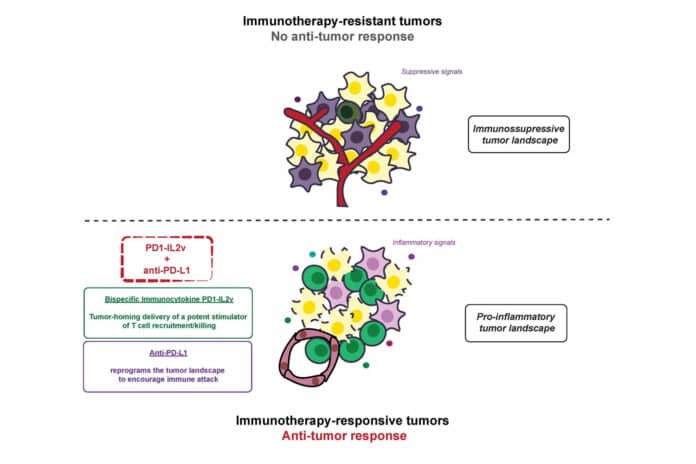Immunotherapy can treat cancer by reprogramming the patient’s immune system to target the tumor. With several documented cases of long-term remission, this innovative strategy has had a substantial impact on the care of cancer patients.
However, many patients either don’t respond to immunotherapy or, if they do, the effects are only temporary. This emphasizes the importance of understanding the mechanisms underlying cancer resistance to this treatment.
By combining a checkpoint inhibitor with a new immunocytokine, scientists at EPFL, Ludwig Institute for Cancer Research, CHUV, and Roche have made a breakthrough in fighting against immunotherapy-resistant cancers.
Scientists have discovered a way to break down the resistance of mice with neuroendocrine pancreatic cancer. This cancer is resistant to a type of immunotherapy called checkpoint blockade. The patient receives a drug (a checkpoint inhibitor) that blocks proteins that generally keep immune responses from being too strong but can also prevent immune cells (T cells) from killing cancer cells.
The scientists looked at an increasingly popular type of synthetic protein-antibody fusion in immunotherapy called an immunocytokine. They focused on the Roche-developed bispecific immunocytokine PD1-IL2v, which may home into tumors and activate killer T cells to destroy the cancer cells causing tumor growth.
The immune checkpoint inhibitor anti-PD-L1 was coupled with the immunocytokine PD1-IL2v to increase anti-tumor immunity against cancer resistant to immunotherapy. When paired with an anti-PD-L1 immune checkpoint inhibitor, “[PD1-IL2v] is considerably more effective,” according to the scientists.
Douglas Hanahan at EPFL’s Swiss Institute for Experimental Cancer Research said, “PD1-IL2v induces stronger and more specific expansion of anti-tumor T cells compared to conventional anti-PD-1 therapy by stimulating a specific subtype of T cells, whereas anti-PD-L1 targets and disrupts barriers erected in the tumor microenvironment, namely pro-tumoral macrophages and tumor vasculature, which collaborate to counteract the anti-tumor immunity.”
Increased survival rates in tumor-bearing mice were achieved by combining the two molecules, which had a longer-lasting therapeutic impact than the bispecific immunocytokine alone. By altering immunosuppressive tumor-associated macrophages and tumor vasculature, the combination increased therapeutic efficacy by making cancer more readily “detectable” by immune cells.
Douglas Hanahan said, “This innovative immunotherapeutic combination sensitizes immunotherapy-resistant tumors infiltrated with PD-1+ stem-like T cells, which have recently been found to be important for sustaining efficacious anti-tumor immune responses, leading to tumor destruction with consequent survival benefit.”
“These provocative results present a rationale for clinical trials to evaluate the combination therapy of PD1-IL2v and anti-PD-L1, perhaps initially in immunotherapy-resistant cancer patients with T cell infiltrated tumors.”
Journal Reference:
- Mélanie Tichet et al. Bispecific PD1-IL2v and anti-PD-L1 break tumor immunity resistance by enhancing stem-like tumor-reactive CD8+ T cells and reprogramming macrophages. Immunity 10 Jan 2023. DOI: 10.1016/j.immuni.2022.12.006
